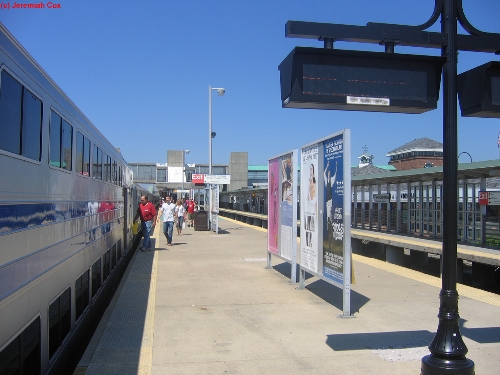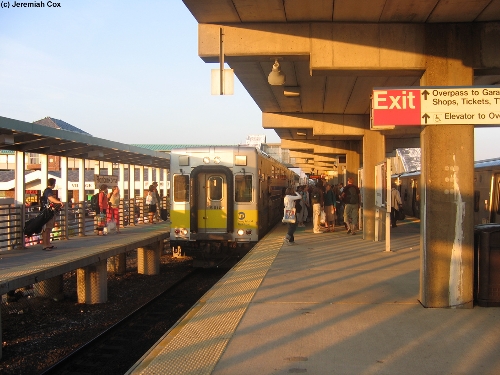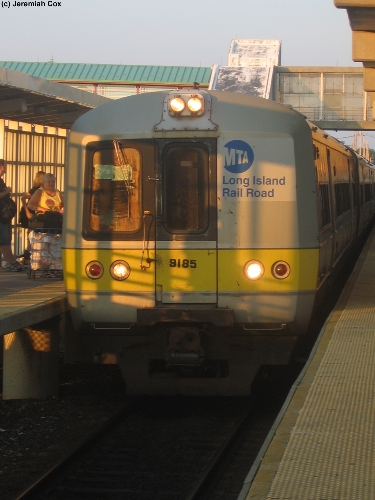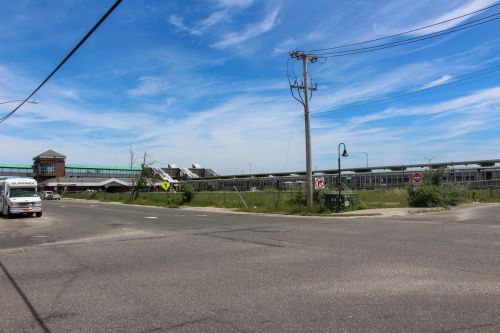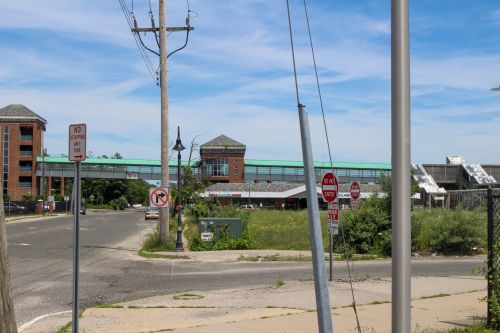


Ronkonkoma is the easternmost end, and farthest point from Penn Station for electrification on the LIRR system. The two other branches, the Montauk and Port Jefferson that run into Suffolk County north and south of the Main Line run only less frequent diesel trains this far east. Electrification reached Ronkonkoma from Hicksville as part of a 24 mile extension of electrification down the Main Line with the first electric trains arriving in December 1987 (electric service was phased into Farmingdale in June 1987) with the faster timetable with all day hourly (except for gaps in the reverse-peak direction due to the one track nature of the branch) one-seat ride service between Penn Station and Ronkonkoma debuting in January 1988. At this point in time service on the remaining 46 un-electrified miles to Greenport was reduced to one or two car long shuttle trains running 2 to 4 times per day, with passengers transferring at Ronkonkoma to hourly or better (with full reverse-peak service starting in 2018 after the line was double-tracked) electric trains to and from Penn Station. All trains terminate at Ronkonkoma; except for one inbound Greenport Branch train that runs in passenger service on the evenings of Summer Fridays only, running non-stop from Ronkonkoma to Jamaica. This is part of a year-round (normally done as a deadhead move) to swap out the trainset used on the diesel shuttle so it can receive maintenance in the diesel Morris Park shops.
During rush hours there is direct service to Atlantic Terminal, and pre-COVID-19 one PM rush hour train that originated at Hunterspoint Avenue. Passengers transferring from electric to the diesel ‘scoot’ shuttle to Greenport walk-up to the front of the platform in Ronkonkoma where their train waits either on the same track or the opposite track across the platform for them. Just east of the station is a large train yard with 11 tracks (soon to be expanded for additional trainsets required for East Side Access) that includes a car wash visible from the station platforms.
The 1988 electrification project rebuilt the street-level Ronkonkoma Station with further additions made in the mid-1990s to expand parking, turning the station into a regional park & ride hub with many commuters driving father to this station over driving to closer stops on the Port Jefferson or Montauk Lines or farther east on the Greenport Branch that receive slower, less frequent and require connections on most trips to reach Penn Station train service. The station is quite well designed to be a busy park and ride terminal. The station has two tracks with trains opening their doors on both sides to three 12 car long platforms 2 side platforms and a middle island platform. Each of the side platforms has various staircases and a ramp towards the eastern end for access. The southern platform exits to Easton Street that forms a kiss’n’ride loop, before a large nearly half-mile long large parking lot with Free Parking. Entrances from Railroad Avenue along its southern side (there are two streets named Railroad Avenue that serve the station) provide vehicular access.
The northern platform has the station’s primary amenities just off (at street level) the center of this platform. There is a brick station house with wood paneled interior walls, a passenger waiting area and a ticket office. There is also a small MTA Police precinct, divided from the ticket office by an outdoor walkway through the buidling. The ceiling of the station house has a gabled roof with weathervanes. Arches with black retro looking letters that spell out Ronkonkoma mark the outdoor passageway through the middle of the depot between the MTA police side and the ticket office. On each side of the station house are two brick buildings containing additional businesses clearly designed for commuters including a Dunkin Donut’s, two local restaurants, and a dry cleaners. These buildings match the design of the station house. On the east side of these amenities is the station’s bus loop with buses stopping directly alongside the northern platform. The area between the bus loop and Railroad Avenue north of the station (there two streets named Railroad Avenue on each side) that bus passengers see while they wait for buses is a vacant lot, designed to be developed into something else transit oriented. To the west of the bus loop, and east of the station house, are additional smaller parking lots with free parking that extend beyond the ends of the platforms (including under the bridge of Smithtown Avenue east of the station).
The middle island platform has two means of access. At the western end of the platform is a simple pedestrian bridge. It is fully enclosed with windscreens and bare concrete walls and framing. In the middle of the platform is the main fully enclosed concrete sided pedestrian bridge with 3 elevators, one down to the island platform and one down to the sidewalk area at street-level along both of the side platforms. There are two staircases down to the island platform and single staircases down to each of the side platforms. This pedestrian bridge continues north to another staircase down to the south sidewalk of Railroad Avenue, jogging slightly at this sidewalk, before continuing across Railroad Avenue to level 3 of a 5 story parking garage built in the mid-1990s. The portion of the pedstrian bridge that continues to the garage is clearly newer with red framework (not concrete), and bricks (not bare concrete) around the intermediate staircase. This parking garage is the only place with monthly reserved parking permits and where daily parking must be paid for. Each of the side platforms is completely covered by a concrete canopy structure, while the island platform is covered between the two footbridges that provide access to it.
The station could be truly multi-modal with the northern side of Long Island-MacArthur Airport just south of the station. Railroad Avenue (that borders the southern parking lot) is just north of the FAA exclusion zones at the ends of the airport’s runways. Unfortunately, the airport’s passenger terminal is on the southern side of the airfield, 4 miles away. Over the years various attempts have been made to provide better rail to plane connections to the airport, although today only taxis (the LIRR claims cost only $5.00 with a getaway package available at times in the 2010s) and an hourly Suffolk Transit bus (not timed for train connections) provide connections to the airport terminal. This is less of an issue than it might seem since MacArthur Airport receives minimal service with just legacy carrier American Eagle service Philadelphia along with low-cost passenger service on Southwest and Frontier Airlines concentrated on Florida and other leisure destinations.
Photos 1-12: June 5, 2005; 13-98: June 20, 2014; 99-103: October 25, 2014
